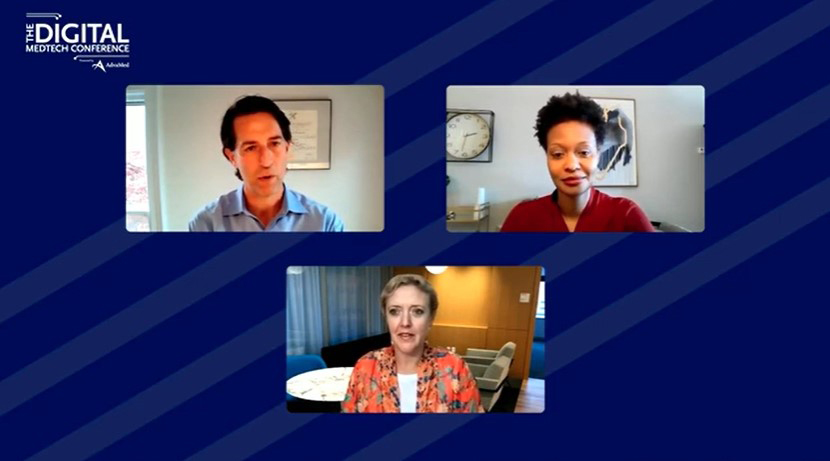When Medtech Meets Consumer Tech It Comes Down To Machine Meets Human
Executive Summary
An expert panel at the recent AdvaMed Virtual Digital MedTech Conference discusses opportunities for medtech and consumer tech collaborations and how to make them successful.
The pandemic has showcased health care’s potential as a growth area for technologies and proven that consumers are willing to embrace wearables, virtual visits, medical apps, and other digital technologies.
For medtech companies, the ongoing transformation of the health care industry will create new opportunities, but also requires a rethinking of their own consumer experience, according to an expert panel discussing “Medtech Meets Consumer Tech” at the AdvaMed Virtual Digital Medtech Conference.
AdvaMed Conference Expert Panel discussion
 (from top left) Pedro Arboleda, Deloitte; Aisha Barry, Advanced Sterilization Products; Sharrolyn Josse, DePuy Synthes
AdvaMed
(from top left) Pedro Arboleda, Deloitte; Aisha Barry, Advanced Sterilization Products; Sharrolyn Josse, DePuy Synthes
AdvaMed
“Consumer technology would not be the same without the experience, this sort of frictionless, magical experience that’s created for the consumer,” said moderator Pedro Arboleda, managing director, Strategy & Analytics at Deloitte.
He highlighted Deloitte’s research on six consumer tech-driven trends that are impacting health care – the coming together of data, personalized care, pricing pressure and transparency, the shift to wellness, speed of care and blurring of digital and human experience – as the springboard for the panel discussion with two medtech industry veterans on what it all means for the future of medtech. (Also see "The Rise And Fall And Long-Term Rise Of Digitally Enabled Health Care" - Medtech Insight, 13 Nov, 2020.)
Sharrolyn Josse, worldwide president of Velys Digital Surgery at DePuy Synthes and Aisha Barry, president of Advanced Sterilization Products, part of Fortive Corp., agreed that the conversion between consumer and medtech has been going on for a while.
Barry joined Medtronic plc in 2016, when Apple Inc. had just launched the Apple Watch, which within just a few short years, made the leap from consumer device to medical-grade wearable.
“Most people didn’t know what atrial fibrillation was until the Apple Corporation started speaking about that, so it’s really changed how consumers think about how they consume information, how they think about their health care and well-being, and that’s exactly what we expected to happen,” Barry said.
She considers herself fortunate that Medtronic was ahead of the trend.
At Medtronic, Barry led the transformation of remote monitoring for patients with implanted cardiac devices toward an integrated digital health care platform, including the launch of the MyCareLink Heart mobile app to support pacemakers in January 2019. Barry noted that the company disproved sceptics who said that older consumers wouldn’t comply with the guidelines by showing adherence of 90%. (Also see "HRS 2020: Medtronic’s Pacemaker Monitoring App Proves Reliable In BlueSync Study" - Medtech Insight, 14 May, 2020.))
When the company brought in a tech company to help develop the patient app and CareLink SmartSync tablet-based device manager for clinicians, it saved a lot of time.
“Most people didn’t know what atrial fibrillation was until the Apple Corporation started speaking about that, so it’s really changed how consumers think about how they consume information, how they think about their health care and well-being, and that’s exactly what we expected to happen.” – Aisha Barry
“It was taking us a lot of time, lots of technology that we were actually struggling with to solve as a medtech company. When we brought in the consumer tech company, [the development] accelerated,” she said.
Blending Of Cultures
Josse said it is a blending of two very different cultures.
“Medtech has an expertise around a pathology, has an expertise around a patient group that has a sickness, we understand the criteria, we understand comorbidities, we understand different treatment options, but a lot of the decision-making process has historically been much more methodical [in a medtech environment that’s highly regulated],” she said. By contrast, the consumer market is all about engaging directly with the patient and other stakeholders on a personal level.
To make these partnerships work requires a deep understanding by both parties of what they are trying to accomplish and identify strengths and weaknesses. She outlined key considerations such as understanding the ecosystem they want to create, having multiple partners to go more broadly or be very focused, and examine competitive boundaries such as for data storage and data insights.
“It all comes back to where do you want to focus, what are you trying to solve for, what unmet needs are you solving for, what are the pain points that you’re trying to solve for, for which customer, and really driving that focus will help them lead into the pathways by identifying who will be the best partner,” Josse said.
She also highlighted the importance of setting boundaries and building upon each other’s expertise and strengths and also for medtechs leveraging existing relationships, such as with doctors and hospitals.
Barry said that data management is often a conversation in progress. “From a medtech standpoint, the stronger your offering is, the more differentiated within your medtech space it is, the stronger your positioning is in that conversation,” Barry noted.
Medtech companies that provide a “me-too” product are not in strong position whereas those that can show strong clinical benefits and superior outcomes have a “seat of influence” in the conversation with tech companies. Josse echoed this view by saying that medtechs have to be competitive with the core technology they are offering and ensure they are creating a connectivity strategy.
“Often times, we build these key capabilities, but we also need to be able to figure out how do we then drive connectivity … to be able to really bring out those key differentiators,” she said.
Medtech is also facing rising competition from start-ups that have developed innovative solutions and services that are complementary to devices, Arboleda noted. (Also see "The Rise Of Digital – Deloitte Offers COVID-19 Recovery Strategies For Medtechs" - Medtech Insight, 22 Apr, 2020.)
“What you’re seeing with successful start-ups is that they are going deep in what we know are critical in the ecosystem and they are developing those proof points with their hospital partners,” Barry said. “I think you’re very well served as a medtech company understanding the full landscape [and those are not just big players].”
Barry said that in her journey from the consumer goods to the medtech and then digital space, she has learned that companies need to be very deliberate in their design.
“Capabilities in the absence of a specific and measured job, customers and consumers won’t adopt it,” Barry said. For example, banking apps work because they do not change and they “do the job,” she said.
